See likes given/taken
| Post info | No. of Likes |
|---|---|
|
Re: Why did the villagers become hostile?
Quote (A80000):j7g0:[!]{072706BC} | There's a northern wall blocking your way! You tried to light a new fire in their fireplace when there were still lit embers from the previous fire. There's a bug where that makes them really mad. They'll forgive you if you go away for a few months. March 30, 2021, 09:52:15 AM |
1 |
|
Re: Trapping advice
Paw board needs to be baited individually. Otherwise you get nothing. Tip of paw board is like “w”, the center being usually bit taller than the sides. The bait is placed in the center. With the board erected upright: to get the bait, fox has to jump up to nudge the bait off. But while nudging the bait; it’ll get stuck on the notch and stay dangling until trapper comes to harvest. If there’s no bait on pawboard, there no reason for the fox/vixen to jump to knock it down; and so will never catch a fox. March 30, 2021, 06:57:08 PM |
1 |
|
Re: Using Fishing Skill to Find Good Fishing Spots
I'm from Louisiana, the 'Sportsman's Paradise'. Fishing doesn't work that way in slow-moving waters, nor in open sea. It certainly would not work that way for ice fishing. People have favorite fishing spots because they've caught fish there, not because their senses tell them it's a good place.
March 31, 2021, 09:50:46 PM |
1 |
|
Re: Why did the villagers become hostile?
This issue is fixed now. It was first reported here: https://www.unrealworld.fi/forums/index.php?topic=5707.0 Villagers mistakenly consider the fire making attempt illegal if there were certain size warm embers at the site. Fixed - persists in 3.63. April 01, 2021, 06:46:26 PM |
1 |
|
Re: A very draft of textilecraft -- fibre processing on its' way
Very exciting update, I've been looking forward to this one for a long time! I practice textile arts as a hobby in real life and have done some research into historical northern European textiles including the trading value of materials and the times it would take to craft different items. If dyeing is ever added as a craft, I have a fantastic research study I've found that I'd be happy to share as a reference. If you have any questions to ask from someone who's done the skill in real life or just want someone to brainstorm textile ideas with, please feel free to contact me! April 10, 2021, 02:00:58 AM |
1 |
|
Fibre processing continues with retting and some spin-off features
By now spinning code is all done and tested and polished, and we're happily able to spin both nettle and hemp yarn. With some new flora_*.txt tags added it's actually possible to add fibre yield for any flora_*.txt plant, although the textilecraft processes are modelled for nettle and hemp. But yes indeed for example flax as a new fibre source can be added relatively easily. We've also added straw, a mere stalk of certain plants, as a new item type. Straws will be a byproduct of threshing plants such as nettles and hemp, but with a flora_ tag of their other plants can be also given straw yield. Straws don't (yet) have specific use of their own but do serve as material for fibre processing. Straw items were added for the sake of being able to thresh valuable plants for seeds and leaves first, and still have the straw remaining for fibre. And now there's "retting" added for textilecraft options. It's a process for separating the fibres from the stalks of harvested plants, and the first and foremost option of them all. Retting is done by soaking the plants in the water for several days. The soaking needs to be done by open water and the sufficient soaking time depends on the water temperature, varying from 5 to even 25 days. The warmer the water, the faster the retting process is. The retting doesn't occur at all in very cold water so it can't be done for example in the winter. However, nettles are a speciality and you can peel fibres from them by hand without retting, but it's relatively slow and mostly used only if small amount of yarn needs to be spun. Now the remaining steps to do on our way to completely finished textilecraft system for fibre processing would be drying the retted plants, and extracting the fibre. So let's continue ... These are future additions - not yet functional in current version 3.63. April 19, 2021, 04:48:22 PM |
1 |
|
Re: Fibre processing continues with retting and some spin-off features
This is a topic I've seen mentioned in the forums a few times before, and decided not to comment (for I've thought that this will be discussed again, once the need to feed livestock gets implemented in the game). So, not going to go into details of this discussion now, when plans for "the need to feed livestock" are just that - plans, and not yet in the works. Just a short mention, one point: As a person living in the countryside, with decades of first-hand experience in feeding domestic animals like horses, cows and sheep, and as a person who has read something about the history of animal-rearing in Finland, and also has first-hand experience about the old traditional breeds like the Finnhorse and Finncattle, I'd like to make a point: "hay for food, straw for bedding" is a relatively modern invention. 1000 years ago it was more like "feed your animals with what ever you managed to gather in the summer", which meant things like dried bunches of broadleaved saplings, moss, straw, and yes - wild hay. (For bedding it was most likely peat and moss). I've seen my own Finnhorses deliberately choosing to eat straw when hay is also available. Those old breeds have digestion all geared towards survival, they like to chew tree bark etc. Finncattle digestion is more like a reindeer, than a modern cow bred for maximum milk production. Oh well. And in case someone disagrees and feels a need to continue this discussion, please do so in "general" or "off-topic" sections instead of dev.news which is for announcing features Sami is working on, not about going into details discussing future plans. May 10, 2021, 06:23:36 PM |
1 |
|
Sneak preview of textilecraft system with screenshots and additional insight
Time for a little sneak preview with our textilecraft test character Kuitu Kaumolainen. Some of the stuff mentioned here has been mentioned before, but a summary about textilecraft is in place now. With some sdditional insight and sidetracking included. So, the biggest single addition to the upcoming version is featuring mechanics to extract fibres from certain plants and process them into yarn. For this, a new TEXTILECRAFT skill was created, and lots of spin-off features regarding fibre processing and cordage also followed. Fibres can be extracted from nettle, hemp and flax - which has been added as a new cultivated plant. Let's start from there ... Flax Flax is an old cultivated textile plant, but in Iron-Age Finland it wasn't even as commonly grown as hemp. One reason for this is that flax doesn't survive in the very north so in the game it's grown only by certain cultures south of Kaumo. As a curiosity, the finnish word for flax ('pellava') originally meant the nettle plant ('nokkonen') which speaks about importance of this age-old wild source of fibre. But nevertheless, flax is in the game now and it can be grown, harvested and processed for fibre. 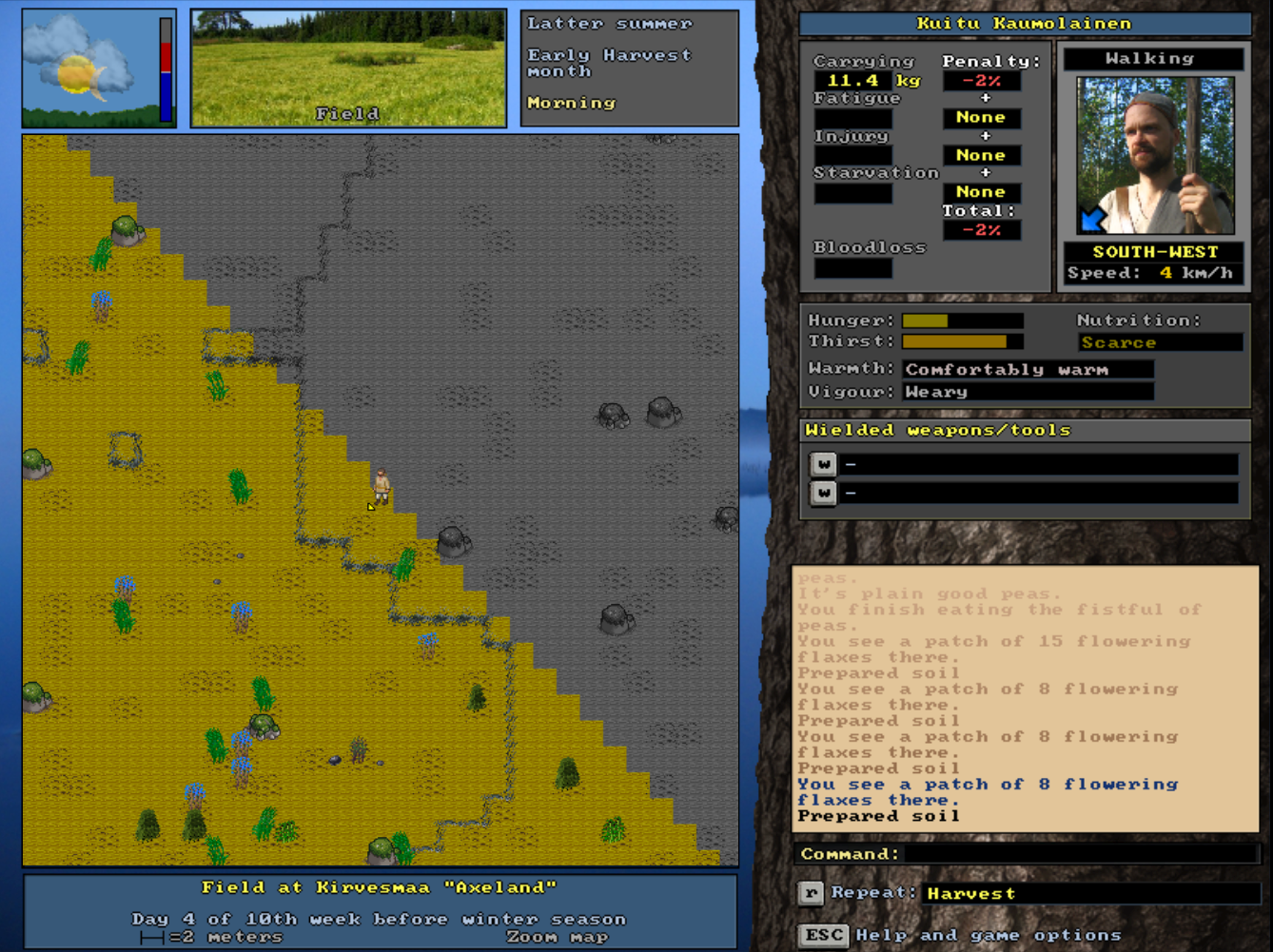 Kuitu Kaumolainen has found his way to Kiesse, a region where flax is grown. At Kaumo where he's from they only produce nettle or hemp fibres. Blue flowering flax is easily spotted from the field, and it could be harvested for fibre already. Textilecraft options Processing plant fibres into yarn involves several stages of work, and it's all done by using your TEXTILECRAFT skill. Character's expertise in textilecraft affects to required working times and the amount of usable fibre or yarn produced. After the plants are harvested the fibres must be then separated from the plant's stalks. This process is called "retting", and it is done by soaking the plants in the water for several days. Sufficient soaking time depends on the water temperature, with the warmer being faster. 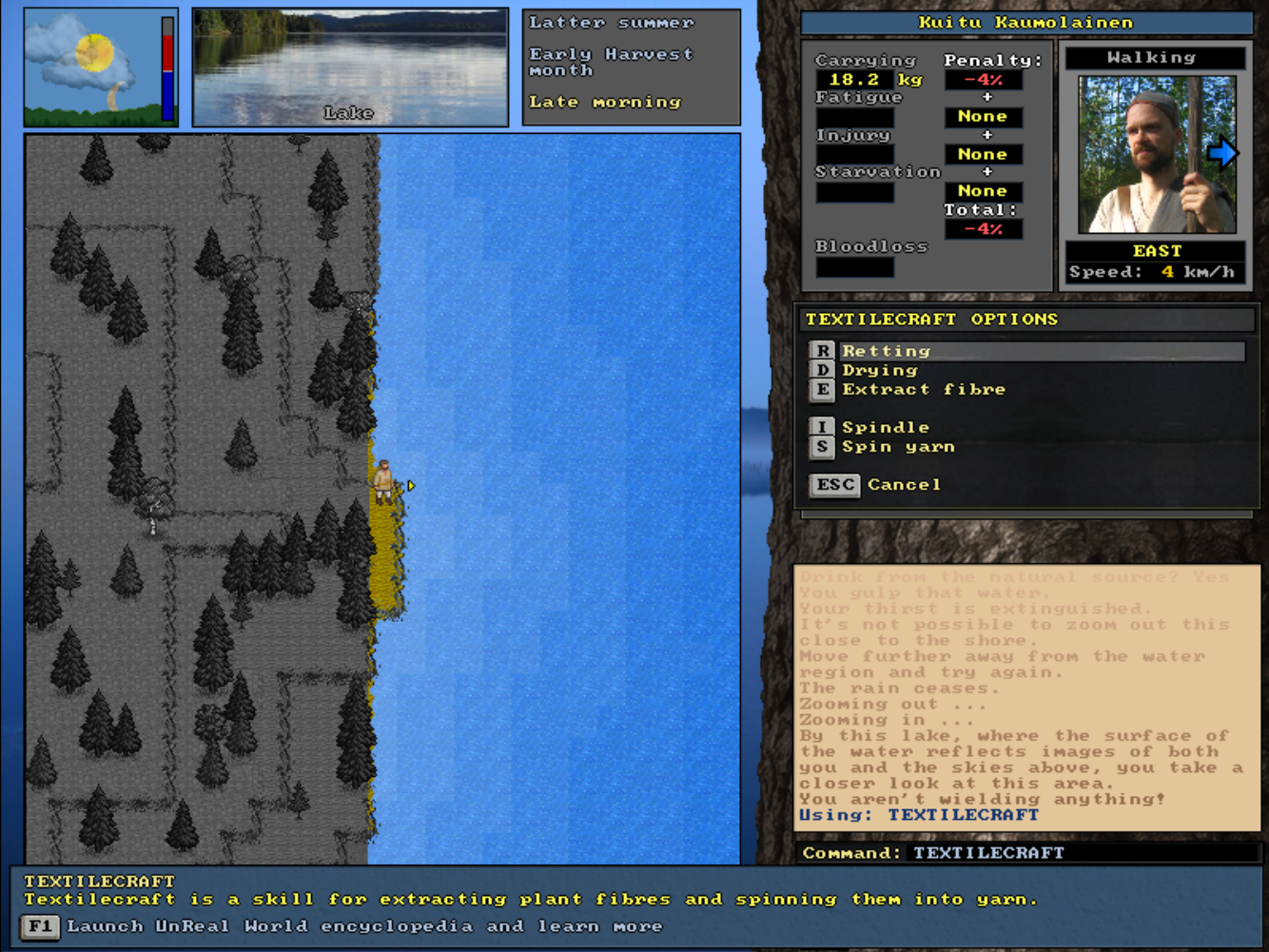 Kuitu Kaumolainen harvested 100 flaxes and headed by the lake to start retting the stalks. Here you can see all the textilecraft options to proceed with fibre extracting and spinning them into yarn. Extracting fibres is hard work It took two weeks for Kuitu's flax to soak properly. After that it took one more week to dry them. And only then Kuitu can start extracting the actual fibre from the stalks. Extracting fibres is done by breaking the dried retted stalks so that the woody core shatters and falls away leaving the loose fibres free. The stalks are beated for example with a club on a solid working surface. Extracting fibres is hard work and commonly carried out with several people working together. Traditionally there has been a custom to arrange specific work parties for processing fibres of each village together with the neighbouring people. And in the game your companions can actually help you with the task. Obtained bundles of fibre are then scraped free from remaining coarse parts. Traditionally special tools were used, but it can be also done by rubbing and whacking the bundles against a hard surface, or with tools at hand. 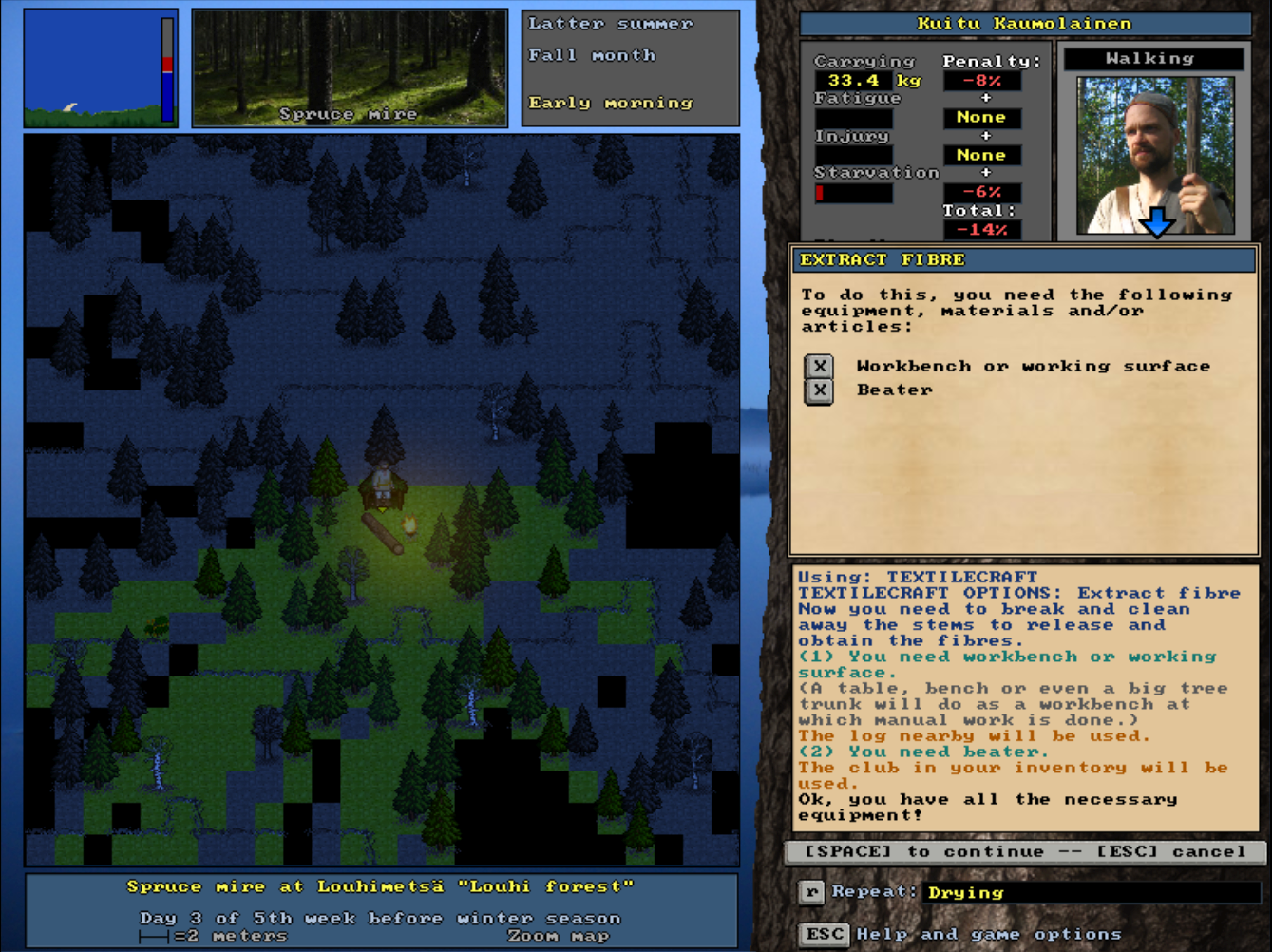 Kuitu starts extracting fibres from the dried retted flax stalks at his shelter. He is about to beat the stalks with a club on top of a log. These dried retted stalks could have been also stored for future and the fibre extracted when there's time and need for that. Spinning yarn It took lees than half an hour to extract the fibres from his 100 flax stalks and Kuitu got 16 bundles of flax fibre. Fibres can be then spun into yarn either by hand, which is slower, or using a spindle. Spindle is also a new craftable item, and very easy to make. So Kuitu crafts a spindle and starts spinning. He decides to go for full length yarn. When starting spinning it is possible to choose how long yarn you wish to spin on one go. 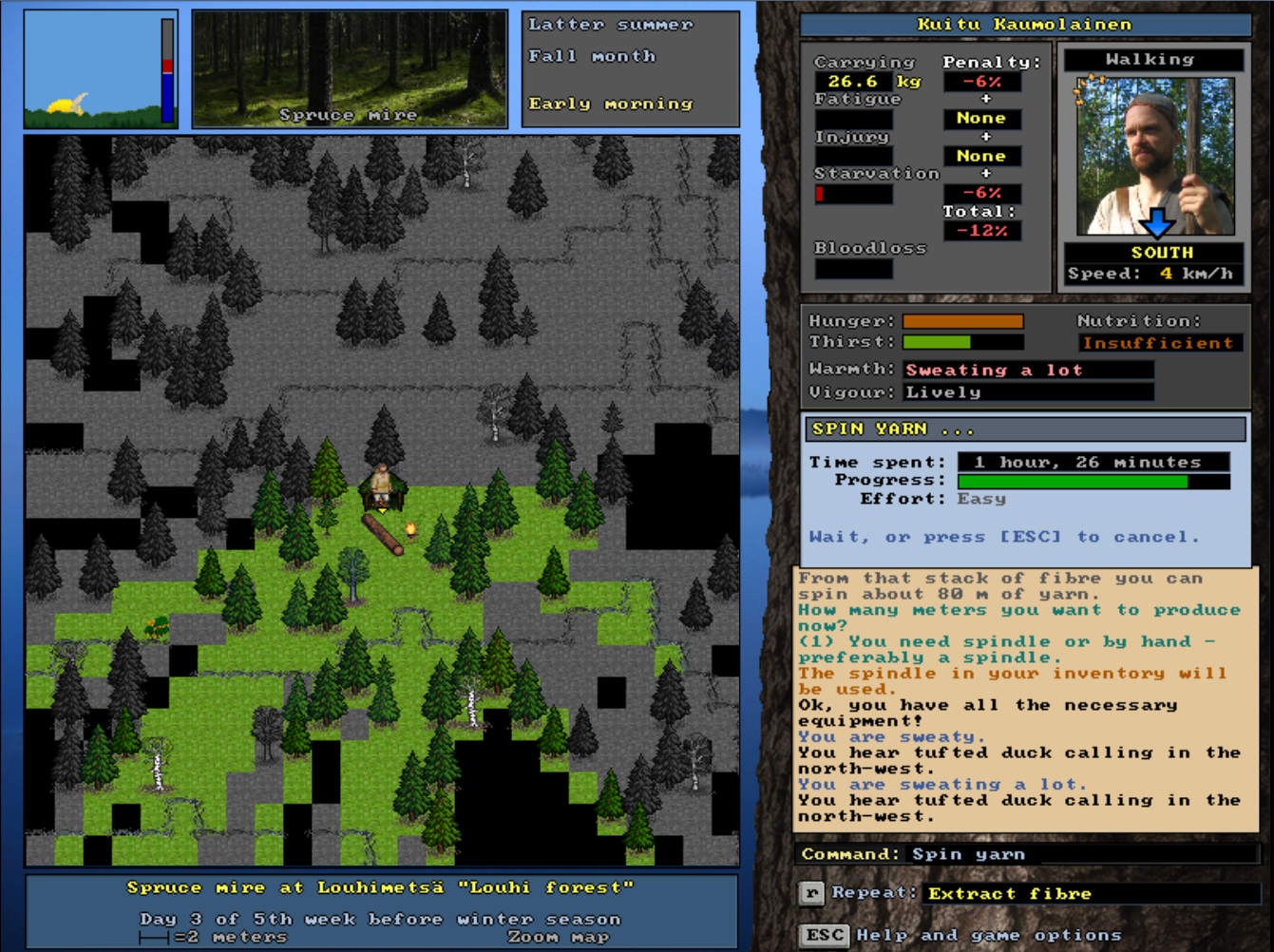 Kuitu manages to spin 80 meters of linen yarn in less than two hours. It could be then used in crafting of different items such as loop snares, arrows - or fishing rods. Nettle specialities In the next version it will be also possible to craft fishing rods, and hooks out of wood or bone. And a working fishing rod naturally needs a line too. Now Kuitu has his linen yarn which could be used as line, but the whole process of extracting flax fibres with retting and drying took weeks. That's quite a long time if there's an urgent need for little piece of yarn. Luckily there's also faster wilderness condition option for utilizing plant fibres - and that is a nettle. Nettle fibres are a speciality as they be extracted directly from the fresh plants without retting and drying processes. To do it you can simply use "extract fibre" option directly to freshly harvested nettles. This method takes more time, but is an useful option when only a small amount of fibre is needed. The nettle stem is crushed by hand, and the fibres carefully stripped off. It doesn't take long before Kuitu finds some nettles. Textile plant harvesting is made possible for fibre even when they are still growing. 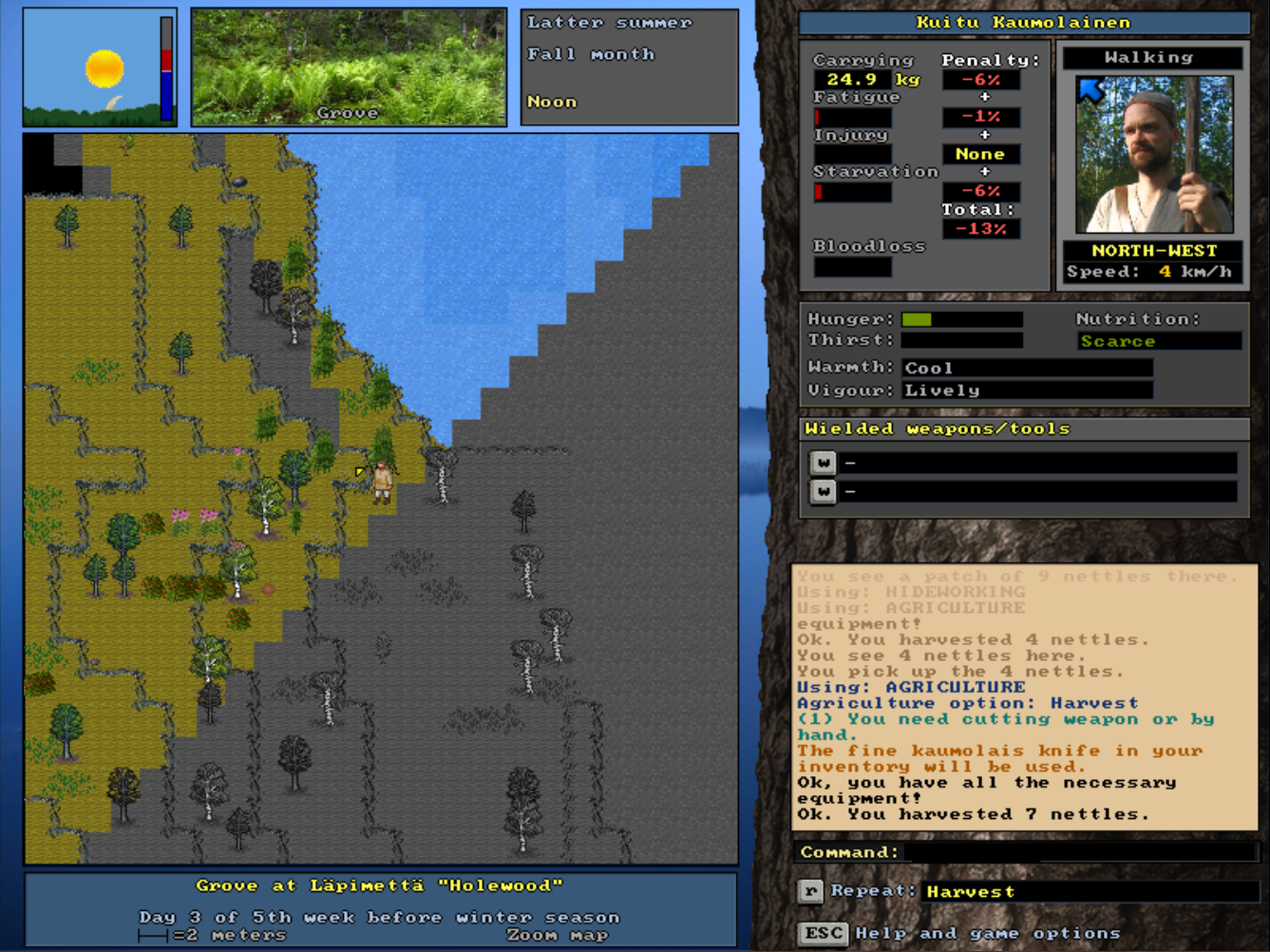 Kuitu harvests some nettles. Then he simply extracts the fibres by hand, and spins some nettle yarn. If he would like to produce a lot of yarn, this would be too slow to be practical, but now he's only after fishing rod line, Wooden hook, nettle yarn - and baits Kuitu finds a slender tree trunk, fashions a wooden hook out of a branch, and proceeds to assemble a fishing rod. Now we should mention that In the upcoming version usage of baits in fishing is also featured. Using baits is not necessary, but naturally highly recommended. Catching a fish every now and then without a bait is still possible, but for reliable rod fishing and decent catches baits are now quite essential. You can use pretty much every food item as a bait and portion of the selected item will be used during the fishing attempt. Pieces of raw meat and fish can be considered decent baits for predatory fish, but for example crumbs of bread may also work for some fish. You can also use a whole small fish, eg. roach or perch, in order to attract a bigger predatory fish. With this addition in effect the type of fish caught with rod fishing is now more dependant on the baits used. It's not likely that you'll catch a pike with an empty hook, but having a small roach as a bait might work. And that little roach might have been caught with quite moderate bait such as bread crumb, or even with some tasty vegetation. 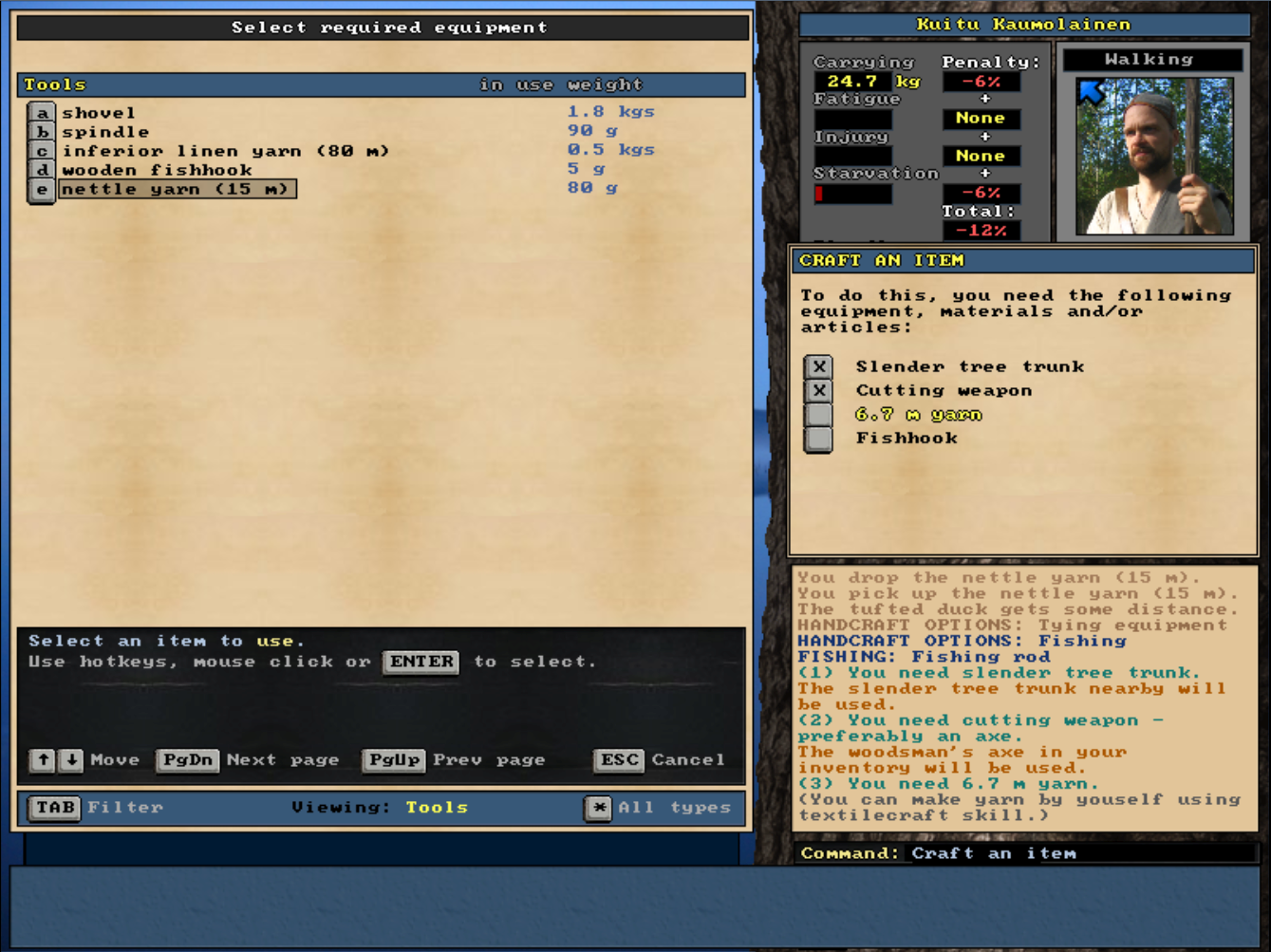 Kuitu makes his survival fishing rod, with a wooden hook and nettle yarn. The work with the several less laborous features continues but we're getting closer to release every day. It's always quite impossible to say when everything is completely wrapped up and working, but maybe - just maybe - we might have this version out in june. Cheers! For those who are more curious about the real life practises here's a short documentary in Finnish showing how the flax is processed. Having read the above I trust you will understand what is happening even without subtitles. The gear used differs slghtly from the more primitive method of the game, but the steps are the same; sow, harvest, ret, dry, extract, spin. https://www.youtube.com/watch?v=TNFD_CUlxZU May 11, 2021, 03:52:38 PM |
1 |
|
Re: Impossible trade, foreign traders' carry limit.
The carry limit based acceptance was indeed introduced due to reason explained by Matti-Patti. The exploit possibility was simply too much for lots of players to resists. But it's indeed been a bit awkward since then and now we've adjusted things so that if the single trader can't carry the traded items they will be distributed among his fellows. The overall limit among the whole group can be still reached with a lot of trading, and then you have to live with that, or trade more high value furs Fixed/Adjusted - persists in current version 3.63. June 03, 2021, 05:00:35 PM |
1 |
|
We're getting closer and closer to new release
We've pretty much finished the actual coding of upcoming release, version 3.70. Or it's more like we have to seize adding new features now if it's going to be released this month. Few of the initially planned features actually needed to be postponed for later, for example skiing NPCs. However, as there's now snow penalty functioning for NPCs and animals it will be kind of like payback time version. See, NPCs have been trudging through the snow ever so easily for many versions, but our skiing characters really have an advantage - for at least sometime. It's likely that 3.70 will be first released as beta version, and it will still grow with lesser features as we continue to work towards the final stable release. If nothing too complicated comes up with our test runs we'll start wrapping the release up in a week or two. June 16, 2021, 04:11:46 PM |
1 |


